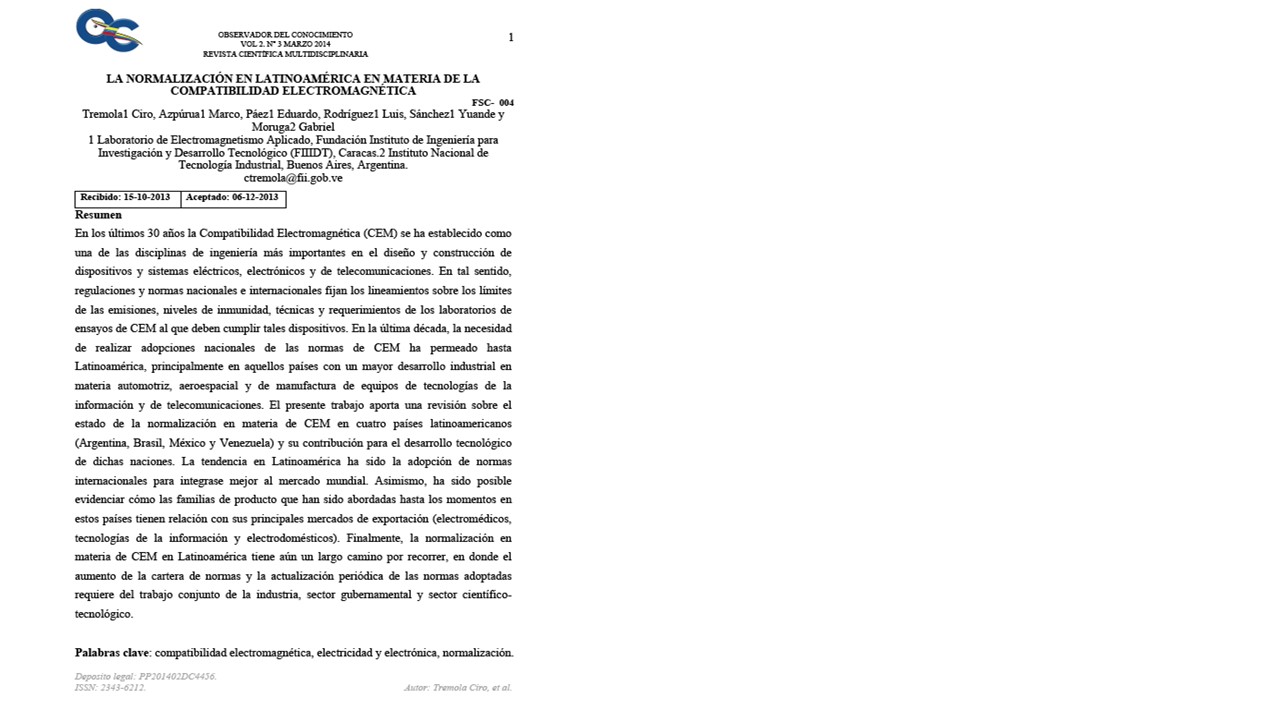Standardization in Latin America in the Matter of Electromagnetic Compatibility
Keywords:
Electromagnetic compatibility, electricity and electronics, standardizationAbstract
In the last 30 years, Electromagnetic Compatibility (CEM) has established itself as one of the most important engineering disciplines in the design and construction of electrical, electronic and telecommunications devices and systems. In this regard, national and international regulations and standards set the guidelines on the limits of emissions, levels of immunity, techniques and requirements of the CEM testing laboratories to which such devices must comply.In the last decade, the need to carry out national adoptions of the CEM standards has permeated Latin America, mainly in those countries with greater industrial development in automotive, aerospace and manufacturing of information technology and telecommunications equipment.
Downloads
References
Balcells, J.; Daura, F.; Esparza, R.; Pallás, R. (1992). Interferencias Electromagnéticas en sistemas electrónicos. Series MUNDO ELECTRÓNICO, Marcombo. 333–343.
CEPAL. (2000). Equity, development and citizenship. México, 3-7 April, Twenty-Eighth Session.
CISPR 16: (2008). Specification for radio disturbance and immunity measuring apparatus and methods - Part 2-1: Methods of measurement of disturbances and immunity - Conducted disturbance measurements, CISPR Standard 16.
De Soto, H. (2001). Competitividad: el motor del crecimiento. IDB.
IDB. (1998/9). Latin America deal with inequality: Economic and Social Progress in Latin America —Report 1998/9. Washington, DC: Inter-american-Development-Bank.
IDB. (2000). Development beyond economy: Social and Economic progress in Latin America. — Report 2000. Washington, DC: Inter-american- Development-Bank.
Instituto de Ingeniera (FII). Revista Espacios. vol. 29 (3).
IRAM 4220. (2003). Aparatos electromédicos. Parte 1: Exigencias generales de seguridad. Sección 2: Norma colateral: Compatibilidad electromagnética. Requisitos y ensayos, IRAM standad 4220. 2003.
Molina, V.; García Ruiz, I; Sepúlveda, F.; Ávila Jiménez, D.; Jiménez López, R.; Martínez, E. (2007). Perspectivas del desarrollo de las normas para la implantación de la CEM en México”. Proceedings of the National Meeting of Electrical Metrology, ENME-2007. Querétaro, Qro. México.
Molina, V.; García Ruiz, I. (2010). Desarrollo de los sistemas de medición para la evaluación de la conformidad con la NOM-121-SCT1-2009. Symposium of Metrology 2010. Querétaro, Qro. México.
Paul, C. (2006). Introduction to Electromagnetic Compatibility. Wiley- Interscience. Segunda edición. 49–89.
Rodríguez, L.; Tremola, C.; Páez, E. (2008). Creación del laboratorio de Compatibilidad Electromagnética (CEM) y Determinación de Parámetros de Antena (APM) para el
Resolución Nª442 (July 2006). “Regulamento para a Certificação de Equipamentos de Telecomunicações quanto aos Aspectos de Compatibilidade Eletromagnética”. AGÊNCIA NACIONAL DE TELECOMUNICAÇÕES.

Downloads
Published
How to Cite
Issue
Section
License

This work is licensed under a Creative Commons Attribution-NoDerivatives 4.0 International License.







